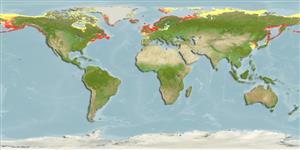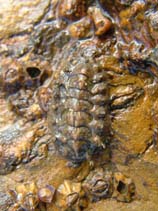Tonicella marmorea (Fabricius, 1780)
Mottled red chiton| Native range | All suitable habitat | Point map | Year 2050 |

|
| This map was computer-generated and has not yet been reviewed. |
| Tonicella marmorea AquaMaps Data sources: GBIF OBIS |
Classification / Names Common names | Synonyms | CoL | ITIS | WoRMS
Polyplacophora | Chitonida | Tonicellidae
Environment: milieu / climate zone / depth range / distribution range Ecology
Benthic; depth range 0 - 183 m (Ref. 128573), usually 0 - 20 m (Ref. 128573). Polar
Distribution Countries | FAO areas | Ecosystems | Occurrences | Introductions
Arctic, Northern Pacific and Atlantic Ocean.
Length at first maturity / Size / Weight / Age
Maturity: Lm ? range ? - ? cm Max length : 2.5 cm TL male/unsexed; (Ref. 281)
Short description Morphology
Oblong to oval in shape; elevated and rather acutely angular valves. Valves: Colored a light tan covered with a heavy suffusion of dark red maculations and specks. Surface of valves: Smooth; granulated under a lens. Lateral areas: Not distinctly outlined. Girdle: leathery and without scales or bristles (Ref. 281).
Found from intertidal to 10 m (Tonicella submarmorea) and 230 m (Tonicella marmorea) (Ref. 75835).
Life cycle and mating behavior Maturity | Reproduction | Spawning | Eggs | Fecundity | Larvae
Members of the class Polyplacophora are mostly gonochoric. Life cycle: Eggs hatch into lecitotrophic planktonic trocophore larvae (no veliger stage) which later metamorphose and settle on the bottom as young adults.
Main reference
References | Coordinator | Collaborators
Burghardt, G. and L. Burghardt. 2006. (Ref. 281)
IUCN Red List Status (Ref. 130435)
CITES status (Ref. 108899)
Not Evaluated
CMS (Ref. 116361)
Not Evaluated
Threat to humans
Human uses
| FishSource |
Tools
More information
Internet sources
BHL | BOLD Systems | CISTI | DiscoverLife | FAO(Publication : search) | Fishipedia | GenBank (genome, nucleotide) | GloBI | Gomexsi | Google Books | Google Scholar | Google | PubMed | Tree of Life | Wikipedia (Go, Search) | Zoological Record
Estimates based on models
Preferred temperature
(Ref. 115969): 0.3 - 10, mean 2.2 (based on 720 cells).
Price category
(Ref. 80766):
Unknown.



